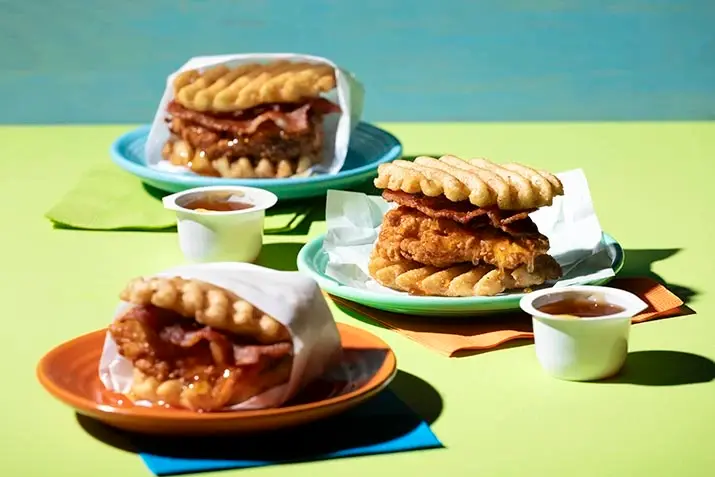New Products
A Flavorful History: Tracing the Origins of Chicken and Waffles
3/22/2024

If you have had the pleasure of tasting chicken and waffles, you’ll instantly recognize the appeal of this unlikely duo. By merging sweet and savory with soft and crunchy, the dish has built an enthusiastic and growing following. Chicken and waffles is up 46% on American menus over the last four years alone.1
Now, thanks to the launch of Simplot® Maple City™ Waffle Flavored Waffle Fries, quick-service restaurants and others can offer this dish to their customers on the go by adding these fries to the fried chicken, chicken tenders and nuggets they’re already serving.
But how did the improbable combination of chicken and waffles come to be?
Like so many things we eat, it’s the result of multiple cooking traditions merging in the New World.
Tracing the origins of fried chicken
Fried chicken, known for its crispy exterior and juicy interior, has a history that spans centuries and continents. The dish’s roots can be traced back to various cultures, but it was significantly influenced by African, European, and American culinary traditions.
Ancient and medieval origins: The practice of frying chicken can be traced back to ancient civilizations. Historical records suggest frying chickens was a technique known in ancient Egypt and Rome. However, these early methods were quite different from the fried chicken we know today.2, 3
African influence: One of the most significant influences on the evolution of fried chicken was African cuisine, with spices and herbs not traditionally found in European cooking. This contributed to the unique flavor profile of what would become American fried chicken.4
European contributions: The Scottish were known to fry chicken in fat (though without seasoning), which differed from the English preference for baking or boiling chicken. When Scottish immigrants settled in the American South, they brought this technique with them, eventually merging it with the African seasoning method.4
Development in the American South: In the American South, fried chicken became an everyday staple. The dish was an economical option for Southern families, as chickens were readily available and cheaper than other meats. Over time, the dish evolved with regional variations in seasoning and cooking methods, symbolizing Southern cuisine.5
Commercialization and global popularity: In the 20th century, fried chicken became a commercial success with the advent of chains like KFC, founded by Colonel Harland Sanders. The fast-food version of fried chicken, with its secret blend of herbs and spices, popularized the dish worldwide.4
Today, fried chicken is enjoyed in various forms across the globe, from the spicy and tangy flavors of Korean fried chicken to the simpler, herb-infused version found in European countries. Each region has added its touch, making fried chicken a versatile dish that continues to evolve.6
Waffles took shape in Europe
This beloved breakfast item, known for its distinctive grid pattern, has evolved through time, influenced by various cultures and culinary traditions.
Ancient Origins: The earliest known waffles date back to ancient Greece. The Greeks cooked flat cakes, known as “obelios,” between two metal plates over a fire. These were not sweet like modern waffles but were primarily made from grains and water.7
Medieval Europe: The waffle’s direct ancestors were the “oublies,” thin, crisp, communion wafer-like cakes that were very popular in medieval Europe. These were cooked over an open flame in iron plates with various designs, including the grid pattern that is characteristic of today’s waffles.7
16th century and the leavened waffle: The 16th century marked a significant evolution in the history of waffles with the introduction of leavening agents, which made them fluffier. Waffles became popular among the upper class in Europe, particularly in the Netherlands and Belgium, where they were often flavored with sugar and spices.8
Colonial America: Waffles were introduced to America by Dutch colonists in the 17th century. The word “waffle” comes from the Dutch “wafel,” which itself derives from the Old French “wafla.” In America, waffles were made the same way as in Europe, cooked over an open fire in iron waffle irons.8
19th-century waffle parties: In the 1800s, waffles began to gain popularity in America, and “waffle parties” became a common social event. The invention of baking powder in the mid-19th century led to the development of the American-style waffle, which is lighter and fluffier than the traditional European waffle.8
20th-century innovations: The early 20th century saw the introduction of the electric waffle iron, which made waffle cooking much easier and more accessible to the average household. This period also saw the popularization of the Belgian waffle, introduced by Maurice Vermersch at the 1964 New York World’s Fair. Belgian waffles are thicker than their American counterparts and have deeper pockets.9, 10
Today, waffles are a global phenomenon, with various adaptations seen worldwide. From the syrup-topped American waffle to the pearl sugar-infused Liège waffle in Belgium and even savory variants like potato waffles, the waffle continues to be a versatile and beloved dish.9
The marriage of chicken and waffles
The earliest version of the American chicken and waffle combo traces back to the Pennsylvania Dutch in the 1600s, where waffles were served with pulled chicken and gravy. A different interpretation, influenced by soul food, emerged much later with the opening of Wells Supper Club in Harlem, New York, in 1938. The restaurant became a favorite nocturnal haunt for jazz artists. These musicians, arriving post-performance and caught between dinner and breakfast, found the perfect solution in chicken and waffles. Notable visitors like Sammy Davis Jr. and Nat King Cole frequented Wells Supper Club, helping spark a national interest in chicken and waffles.9, 11
In 1975, Harlem-born Herb Hudson opened Roscoe’s House of Chicken and Waffles in Los Angeles. The restaurant quickly became a fixture in the Los Angeles music and entertainment scene. Roscoe’s rose to such prominence that it even drew a visit from President Obama in 2011.11
Chicken and waffles has seen various adaptations over time. The classic version consists of seasoned fried chicken served atop a buttermilk waffle, often drizzled with syrup or honey. Some contemporary versions play with different batters and seasonings for the chicken and add-ons like bacon, cheese, or spicy sauces to create a fusion of flavors.
To be sure, with maple syrup and toppings, chicken and waffles is not easy to eat on the go or in a car. This explains why less than 1% of quick-service restaurants have offered this popular dish.1 However, with new Simplot® Maple City™ Waffle Flavored Waffle Fries, the door is now open to these restaurants and others to share in the chicken and waffles phenomenon. (For an innovative, new breakfast potato option, check out Simplot® Maple City™ Waffle Flavored Waffle Bites.)
Chicken and waffles, a national treasure
Chicken and waffles is a dish that symbolizes a convergence of different culinary traditions and cultures. It’s a testament to how food can transcend cultural boundaries and create new, beloved traditions. The dish continues to be enjoyed widely, with each region and chef adding their unique spin to this classic American comfort food.
1 Datassential, MenuTrends, 2023
2 Who Invented Fried chicken? A History and Evolution of Fried Chicken
3 Who Invented Fried chicken?
4 The surprising origin of fried chicken
5 Fried chicken
6 13 Styles Of Fried Chicken Around The Globe
7 These Beautiful Medieval Wafer Presses Are Where Waffles Come From
8 Waffle
9 The History Of The Belgian Waffle, Which We've Apparently Been Eating All Wrong
10 Pass the syrup and enjoy a slice of history for National Waffle Day
11 Discover the History of Chicken and Waffles



